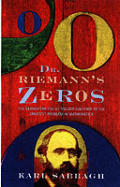
| Publisher: | Atlantic |
| Copyright: | 2002 |
| Printing: | 2003 |
| ISBN: | 1-84354-101-7 |
| Format: | Trade paperback |
| Pages: | 279 |
The truth of the Riemann hypothesis is one of the most famous and most significant unsolved questions in mathematics. It was first put forward in 1859 and was one of the Hilbert's 23 unsolved problems in mathematics, listed in 1900 in a lecture at the International Conference of Mathematics. One hundred years later, it's the only one of Hilbert's problems included in the Millenium Problems of the Clay Mathematics Institute. There is a one million dollar prize for a proof or disproof of the hypothesis.
Unlike the map coloring problem or Fermat's Last Theorem, the Riemann hypothesis is somewhat opaque to the non-mathematician. It is, briefly:
All non-obvious zeros of the zeta function are complex numbers with real part 1/2.
Even those who have had enough math (or engineering) to know what complex numbers are may be stumped by the "zeta function" reference. And even if you know what the zeta function is (it's usually mentioned in passing in college calculus, since it's a fairly obvious infinite series and the Basel problem is a fun bit of mathematical trivia), it's far from obvious why anyone would care enough to make a hypothesis about it.
This is where Sabbagh comes in.
Writing a book like Dr. Riemann's Zeros is harder, I think, than writing a popular science book. Explaining the weirdness of quantum physics is difficult, but physicists thrive on analogies, physical explanations, and mental images, many of which are within the grasp of the lay reader. Mathematics, particularly the deepest problems in mathematics, are another matter. And while the eventual proof of Fermat's Last Theorem involved math fully as esoteric as anything involved in the Riemann hypothesis, the starting point is at least simple algebra. Here, the reader has to understand infinite series and complex numbers before one can even get started.
I'm a more forgiving audience for this than many, since I've had three years of college mathematics, but I think Sabbagh does a great job. He provides a refresher course in various bits of mathematics in the appendix, is confident enough in his readers to show the details of important proofs and formulae, but also explains in clear English the relevance of the equations and relations. The best part, from my perspective, was that I was never bored while he was explaining the details of a bit of mathematics I know backwards and forwards. I'm not sure if someone with no prior knowledge of complex numbers, or someone hazy on logarithms and exponents, would be able to follow this book, but I think they'd have a good shot. And anyone with enough math to be interested in searches for prime numbers should have little difficulty.
Prime numbers are why Riemann's hypothesis became important, but Sabbagh does a great job showing other implications and giving an impression of the work already built on the hope that Riemann's hypothesis is true. His discussion of why Euler's proof of an identity between the zeta function and an infinite product is so significant is particularly good, as is his discussion of the history of prime number searches and the properties of prime numbers. Before starting this book, the Riemann hypothesis was just one of those things I'd heard of in passing and was vaguely curious about; now, I'm fascinated, and will likely read more.
For someone who was not corrupted by George Gamow at an impressionable age, Sabbagh also offers some interesting stories of personalities. This primarily means Louis de Branges, an erratic mathematician with a habit of leaving large sections of his proofs as exercises to the reader, but one who has solved a significant problem in mathematics and therefore can't be entirely dismissed. De Branges is a tragic story of someone who can't seem to bring himself to communicate in a way that others would receive and who has set himself at odds with nearly the entire mathematical community. He's just one of the stories that Sabbagh tells, though, in a meandering narrative around the edges of the Riemann hypothesis problem and into some surprising territory (such as the eerie similarities between the zeroes of the zeta function and spectral properties in physics). I thought Sabbagh provided some insight into how it feels to work in mathematics and the weird turns and multiple approaches to problems of this sort, and he does so without the sensationalism and forced emotion of some other popularizations.
This book is, at times, a bit of a random walk. Since there was no confirmed proof by the conclusion of the book (de Branges has since claimed a proof, but few if any believe him), there is no clear narrative line to follow, no reason to discard any of the possible avenues that have been explored. That makes it hard to find a narrative line, and Sabbagh instead explores the field and tries to give the reader a taste of the wide ranges of mathematics involved. This makes Dr. Riemann's Zeros more a source of interesting facts and trivia than a clearly structured book. But, for that drawback, it's informative, respectful, and best of all, not sensationalist or condescending to the reader. Highly recommended if you are interested in problems of pure mathematics, and generally recommended to anyone curious about mathematics and unafraid of a few complex numbers and infinite series.
Update: While this is a good book about the Riemann Hypothesis, I've since read Marcus du Sautoy's The Music of the Primes and it's much better. It wouldn't be a bad idea to read both, but if you're going to read only one book on the Riemann Hypothesis, I recommend The Music of the Primes instead.
Reviewed: 2007-05-21